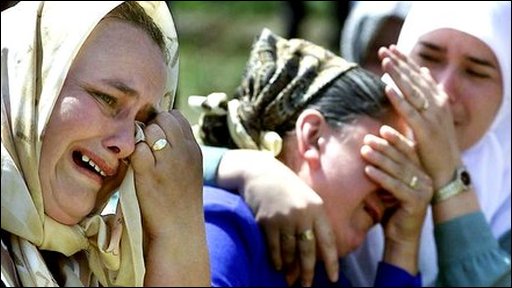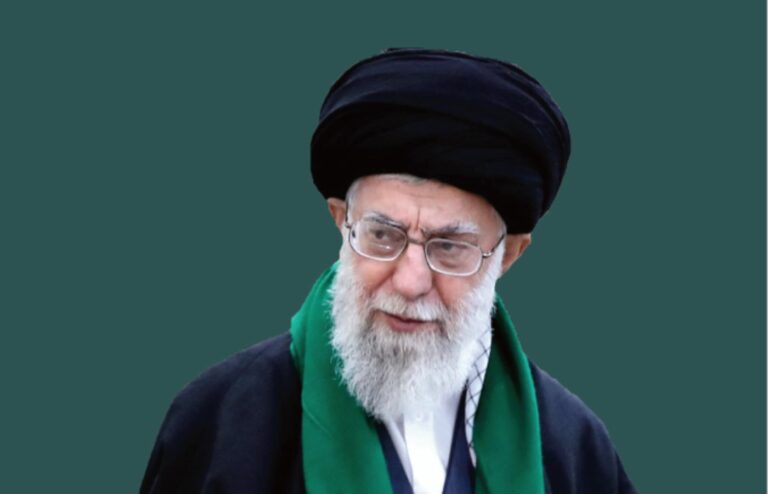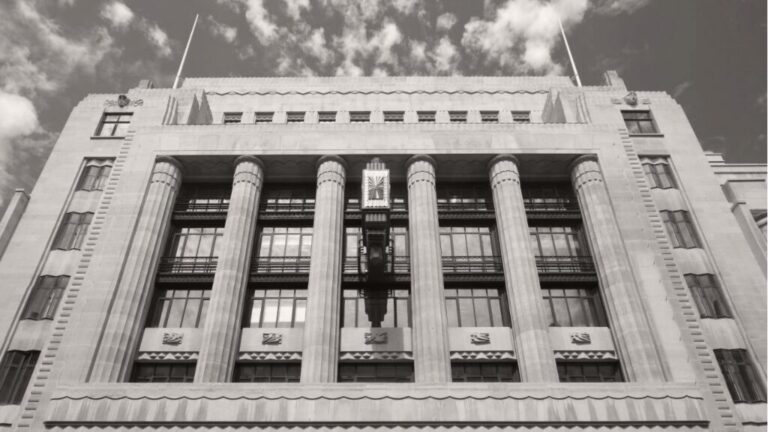written in 1996
“How should ye not fight for the cause of Allah and of the oppressed among men and of the women and the children who are crying: Our Lord! Bring forth from this town of which the people are oppressors! Oh give us from Thy presence some protecting friend! Oh give us from Thy presence some defender!”
Quran 4:75
The war that ravaged Bosnia for four years needs no introduction. From 1992 – 1996, over half a million Muslims were killed, 2 million have been made refugees, and 80,000 women have been raped. Every day of this war has seen the most unspeakable atrocities committed against ordinary civilians. This paper cannot even begin to outline the horror of these years. What it aims to do is to briefly examine the prelude to, events of and aftermath of two weeks in July 1995, in what was supposed to be a United Nations safe-area.
A brief history of Srebrenica, 1992 – 1995
Srebrenica is a town in eastern Bosnia and was under siege from Serb forces from April 1992. The result was that Srebrenica was cut off from food and medical aid, save a few convoy attempts from the UN and two airdrops by the US. The latter were said to be highly inefficient, dropping supplies into Serb held areas. The latter part of 1992, saw the Serb military machine sweep through eastern Bosnia, “ethnically cleansing” Muslims from every inch of land. Srebrenica, lost many inhabitants due to the Serb bombardment, as well as to injury and hunger and its accompanying sickness.
On April 15, 1993 the Serbs launched a massive offensive against the town. The United Nations intervened. On 16 April, the Security Council declared Srebrenica a safe area. The name belied the reality of the situation. The Serbs had agreed to halt their advance on the town, and other enclaves in return for the disarming of Muslim forces in those areas by the UN.
Srebrenica was not so much a safe are as a besieged area. Its peace-time population was 18,000. In April 1993, there were 42,000 inhabits, as victims of ethnic cleansing in the vicinity sought sanctuary.
By July 1995, the situation was much the same. The troops stationed at the central UN base at Potacari were from the Netherlands. Their service in Srebrenica earned them double pay. Their mandate was to protect the inhabitants from ethnic cleansing. As the UN could not be seen to be taking sides, the Dutch peace-keepers were also to ensure that the Muslims remained unarmed. They kept the latter part of their terms.
On July 6, 1995 the Serbs began an offensive on the town. On July 11, Dutch peace-keepers handed over Srebrenica to the Serbs, in what was described as the fall of Srebrenica. Bound to protect the inhabitants, Sgt. Johann Bos1 described the Dutch position to the British press afterwards:
“I found myself standing on a ridge with the Muslims behind me and the Serbs in front of me. Well, I wasn’t going back. So we waited, and after a while the Serbs came and told us that if we surrendered we would be well treated, and we would go home as soon as possible. So we gave up our arms and equipment and that was that . . .”
What followed was what has been described by the United Nations as the worst act of genocide since the Second World War. Forty thousand Muslims were expelled from Srebrenica. Of that total, three thousand are confirmed dead, killed by Serbian execution squads. Eight thousand are missing, but are presumed to have met the same fate.
Men were separated from their families in front of the peace-keepers in Potacari, and locked up in a nearby warehouse. They were visited by the Serb warlord Ratko Mladic the next day, who informed them they would be exchanged for Serb prisoners. They were taken away, but not for an exchange. According to one survivor of the horror that followed, they were transported to a sports hall about 22 miles north of the town, in Krizevci. In total about 3000 men were crammed into a hall about 600 yards square. On July 14, Mladic appeared again, and informed the men that the prisoner exchange had been arranged. The men were then transported under armed Serb guard to a field. This is now the site of one of the six mass graves being excavated and examined by investigators for the war crimes tribunal. According to the three survivors of that night, all the men transported there were lined up and shot.
The pattern repeated itself around Srebrenica. The thousands of elderly, women and children expelled from the town, were forced to march across no man’s land to the nearest Bosnian government held position, Tuzla, sixty miles away. Thousands are still missing from this trek. It is estimated that in total 12,000 civilians, mainly men were killed by the Serbs. In one example of the mass exodus, a column of 12,000 set out on July 11, less than half survived the trek. Parts of the column were ambushed by the Serbs, and the fate of the men marching is the same as that of their brothers in the fields and woods in the Krizevci / Sahanici area as well as Nova Kasaba, Bratunac, Potacari, Konjevic Polje, Milici, Kamenica; in the factory at Karakaj where an estimated 2,000 were killed and the warehouse at Kravica where another 2,000 met the same end.2
Serbian pride
“If I could ask you to publicise that one of the Serbs, in particular my brother, helped the Serbian people and imported arms – or as you say smuggled them – I would be proud.”
Momcilo Krajisnik, speaker of the Bosnian Serb ‘Parliament.’
Terminology in the reporting of the war has been confused. The appellation Bosnian Serb for the followers of Karadzic, implies that the war was a civil war. This idea had been promoted by amongst others Lord Carrington3 , when he was the EC mediator at the beginning of the conflict, and Jimmy Carter the former US President, who intervened in 1995, famously referring to Karadzic as, ‘President Karadzic.’
What the term Bosnian Serb camouflaged was the participation of Serbia, under the direct orders of its President Milosevic. The aims of both Milosevic and Karadzic were the same – Greater Serbia extending across what was formerly Yugoslavia. In the lead up to the Dayton peace accord, the US was keen to promote Slobodan Milosevic as a peace broker in the region. This was despite the continuous failure of Milosevic to heed international punitive measures such as sanctions against Serbia, to prevent him from helping the Serbs in Bosnia.
Milosevic’s own history is hardly that of a peaceful man. Formerly a highly ranked communist in Yugoslavia, he became a firebrand nationalist towards the end of the eighties, actively promoting the Serbian supremacy myth. During the Bosnian war, Serbia openly supplied arms, fighters and other supplies including oil to the Serbs in Bosnia.
The US, UN, the Bosnian government and various other investigations have proven that Serbia was directly involved in the offensive on Srebrenica. Further the finger points to Milosevic, but he is yet to be indicted by the war crimes tribunal in the Hague.
The Serbian involvement took many forms. The Orthodox Church’s involvement in promoting the war is indisputable. In the words of Tadeusz Mazowiecki4 , the church induced a “There-is-worldwide-anti-Serbian-anti-Orthodox-conspiracy-with-goal-to harm-Serbian-population” feeling5 . It sanctioned the war as a ‘holy one,’ a call which was echoed by the Orthodox churches in Greece and Russia, where prominent Serbs including Karadzic were given a hero’s welcome on visits during the war. This in turn provided financial aid from abroad, as well as Russian intransigence on the UN Security Council.
The supply of men has been confirmed from a variety of sources. To cite a few examples, witnesses of the round up of prisoners in the village of Konjevic Polje say a Serbian captain was in charge. The officer was later captured by Muslim soldiers and claimed that he was following orders from Belgrade, which were not to allow any Muslim men to escape from Srebrenica. Also at the detention centre in Bratunac (the Vuk Karadzic school) the few survivors identified Serbian officers and soldiers from their accents.
The notorious Belgrade paramilitary leader “Arkan” 6 responsible for many of the worst atrocities committed in the four years, was sighted in Srebrenica. Dutch peace-keepers also spotted members of Serbian paramilitary groups. Muslim soldiers captured jeeps with Yugoslav Army licence plates from forces that attacked Srebrenica.7
Ratko Mladic was a regular visitor to Belgrade in the weeks preceding the offensive and the massacres. Mladic was sighted by survivors of the massacres at four execution sites just before or during executions. He was widely shown on international television, “assuring” Muslims they would be protected, after the Serbs took the town.
US intelligence units intercepted radio contact on several occasions between Mladic and Yugoslav Army Chief of Staff General Momcilo Perisic. The latter was actively planning the offensive with Mladic. From transcripts made available to some journalists, it appears that the initiative for the attack was from Belgrade. Further Perisic commanded the actual attack against the town between 6 and 11 July. These incidents beg important questions regarding the involvement of Western intelligence (see below) and the culpability of Milosevic. It is well known that the Serbian army, and for that matter “Arkan” and other chetniks8 are tightly controlled by Milosevic.
Despite the imposition of sanctions by the international community, Serbia continued to supply arms and men to the Serbs in Bosnia. Although Serbia promised in mid-1994 that it would no longer help the Serbs in Bosnia in an attempt to get sanctions lifted, their disregard for the sanctions indicates that the measures the international community took were either not punitive enough, or were in turn being breached by allies of the Serbs like Greece and Russia. As the quote from Momcilo Krajisnik regarding Srebrenica confirms, arms were supplied from Serbia to the forces attacking Srebrenica. Krajisnik has been accused of working with his brother Mirko (referred to above) to bring explosives and ammunition from a Serbian munitions factory in Kragujevac. Whilst Momlico Krajisnik officially denied the claim when questioned, he gave the above statement.9 He has not been indicted, and on the contrary he has been regularly dealing with IFOR and NATO this year.
The United Nations: Keeping whose peace?
“Srebrenica was a safe zone, but was given up to the Serbs . . .No-one tried to defend Zepa at all . . .Srebrenica and Zepa should have been fought for. It wasn’t done for reasons unknown to me, and this meant a carrying on with the inactive politics, that is, the unprotection of the protected zones.”
Tadeusz Mazowiecki, September 1995 .10
The Dutch
The moral culpability of the Dutch peace-keepers is beyond question. As the testimony from soldiers like Sgt. Johann Bos shows, there was no second thought given to the surrender of Srebrenica by the peace-keepers. On the contrary, according to the Dutch soldiers own admissions, they saw the Serbs as their allies. Of the 350 peace-keepers, many testify to their feelings of relief when they saw the Serbs. General Hans Couzy, the Dutch army’s Chief of Staff confirms the ‘euphoric mood’ he found at all ranks, that the Serbs were the good guys. 11
For the Muslims, the Dutch betrayal was multifaceted. Instead they were in turn surrendered to the Serbs. Before the surrender, the Muslims still expected protection from the Dutch. On July 11 thousands flocked to the Dutch compound on the outskirts of the town. The Dutch said they could only take the sick and wounded, and a mortar bomb landing in the crowd, prompted the Dutch to take a convoy of the wounded to Potacari. Hundreds of the desperate tried to cling onto the trucks – many fell under their wheels and were crushed.
Video footage taken by the Serbs, shows the Dutch at Potacari watching as Muslim men were separated from family, and sent to their brutal fate. Their commanding officer Lieutenant Colonel Ton Karremans was videotaped drinking champagne with Mladic. Initially the Dutch Defence Ministry denied allegations of complicity. With the video evidence however, they have been forced to acknowledge their presence at the times of atrocities. A document has also been found, which was signed by Dutch officers, countenancing Serb actions – approving of ethnic cleansing, and absolving the Serbs. The Dutch’s moral complicity is compounded by embarrassing admissions from the defence ministry that crucial photographic and video evidence in their possession, of atrocities committed by the Serbs has been destroyed. 12
Akashi and Janvier
Yasushi Akashi’s and Bernard Janvier’s special relationship with the Serbs in Bosnia, was not unknown before Srebrenica. They was already under deep criticism from different parts of the UN operation itself in Bosnia. General Rupert Smith, when commander of UN forces in Bosnia, came into direct conflict with Janvier over his reluctance to use air strikes against the Serbs. Akashi admits that he authorised Janvier to meet Mladic, when the Serbs took peace-keepers as hostages in May 1995. French sources admit that Janvier came to an agreement with Mladic that there would be no more air strikes.
Janvier’s compromise with the devil, found its precedent in Akashi’s long term behaviour. In 1994, General Rose, telephoned Akashi for help, in evacuating an SAS patrol. He asked for close air support. Akashi was then lunching with Karadzic and refused.
During the build up to offensive on Srebrenica, there were repeated calls for the use of air-strikes to prevent the fall of the safe-area. Investigations have shown that Janvier explicitly refused the use of air-strikes to protect Srebrenica. This was despite the fact that various aspects of the UN mission in Bosnia, had recorded the movement of men and arms from Serbia to the Serb forces besieging Srebrenica. Akashi and Janvier stand accused of failing to pass this information on to the Security Council. Leaked memos from the UN, show its concern with Akashi’s silence at a time when it was obvious he must have known that Srebrenica would fall without extra help.
The United Nations heirachy has not taken any measures against Akashi. He has instead moved up the UN ranks. Whilst they may have expressed their concern at one of their envoys misleading them, in the final analysis, Akashi has been rewarded for his stint in Bosnia. The UN’s “concern” to hardened observers of their activity in Bosnia, is cosmetic.
This desire to beautify the ugliness of four years in Bosnia, extends to the International War Crimes Tribunal (see below) set up by the UN. Its Convention on the Prevention and Punishment of Genocide13 states that complicity in genocide is a punishable act. Whilst lawyers will wrangle over the interpretation of the phrase – the deliberate withholding of information, and refusal to permit air strikes by Akashi and Janvier, were both instrumental to the fall of Srebrenica and hence the atrocities that followed. The genocide that took place after the Serbs took over, was exceptional only in the sheer scale of it all. No-one could have doubted the Serb brutality that would have followed if the UN allowed Srebrenica to fall.
The US and NATO: Heroes of Our Time?
“The US has played a very dirty game.”
The US always made loud noises about the atrocities being committed in Bosnia. Until Dayton paved the way for IFOR14 , they never let a single troop set foot in Bosnia. Still, Presidents Bush and Clinton, have always taken the moral high ground – accusing Europe of complacency as genocide was committed on its doorstep Once more the US could lord over Europe – pointing to its own intervention in bringing about a “cessation of hostilities,” at the end of 1995.
NATO of course, headed by the US, used its mighty air power to bring the Serbs to their knees – at least until peace-keepers became hostages. Whatever the US has said, Vance-Owen split up Bosnia, so does Dayton. Ethnic cleansing has been rewarded with a Serb entity inside Bosnia, functioning as a state.
It is not only the people of Bosnia who are cynical. There are acrimonious exchanges between NATO allies, the UN and UNPROFOR. All blame the other for Srebrenica, belying their own culpability. The tapping of telephone conversations between Mladic and Perisic planning the assault, are credited to US intelligence which is known to have been tapping phone lines between Serbia and Serb held territory in Bosnia. The plans for the assault took place on an almost daily basis from as early as June 17, 1995. NATO claims that the US did not share this and other information with its allies, or the UN and UNPROFOR. They point to film material from unmanned US aerial vehicles, showing the deployment of forces, tanks and artillery units around the town in the build up to July 11.
However as the UN has already acknowledged the receipt of this information by Akashi, their cries of being misled are slightly suspicious. NATO allies are also accusing Washington of holding back evidence of atrocities, claiming they have air surveillance pictures of some of the mass executions. As the Dutch have already shown, evidence of Serb atrocities can disappear easily and effectively.
The question is not who is telling the truth, so much as how far are NATO and the US accomplices the United Nations policy of ineptitude and betrayal? As the investigations into the mass graves continues, it is worth noting that the US and NATO have refused to allow their troops to guard the sites of mass graves, whilst investigations continue, despite evidence of tampering by the Serbs. Col. John Batiste, who is the commander of the American brigade protecting investigators confirmed in April that US troops would not protect sites while the investigators were not working. If parties that are verbally committed to justice are prepared to let evidence disappear, despite having a mandate to protect it, the future augurs ill for justice in Bosnia.
International Justice on trial
The war crimes tribunal in the Hague has indicted three Serbs to date, for their role in Srebrenica.
If the example of the International Court of Justice, is a precedent, then there seems little point in its activities. To give one example, in 1986, the court found the USA guilty of breaking international law in Nicaragua. It judged that substantial reparations were due to Nicaragua from the US, and gave both countries a time in which to come to an agreement as to a sum, before it ordered an award.
The US Congress voted to give the President additional money to fund the Contra rebels in Nicaragua, in defiance of the court’s findings. It also obviously vetoed a proposal that the Security Council, of which of course it is a member, should enforce the court’s judgement.
If countries have no fear of defying international organs of justice, what hope has the war crimes tribunal got? Whilst the Serbs have a permanent ally in Russia on the Security Council – history can easily repeat itself.
The following have been indicted for their role in Srebrenica.
Drazen Erdemovic The charges against him are a crime against humanity15 and violation of the laws or customs of war .16
“On or about 16 July 1995, Drazen Erdemovic did shoot and kill and did participate with other members of his unit and soldiers from another brigade in the shooting and killing of unarmed Bosnian Muslim men at the Pilica collective farm. These summary executions resulted in the deaths of hundreds of Bosnian Muslim male civilians.”17
Drazen Erdemovic is in custody in the Hague.
Radovan Karadzic and Ratko Mladic for their part in the orchestration of events. International arrest warrants have been issued for them, but they are not in custody. At the time of going to print, it is still unclear whether Radovan Karadzic will be contesting ‘Presidential’ elections in the Serb entity. Already it seems the International Tribunal has little credibility in the eyes of the perpetrators.
Srebrenica exemplifies Serb brutality over the four years of war. It is also a microcosm of the oppression of Muslims the world over be they in Bosnia, Chechnya, Kashmir, Algeria or Palestine. The list of smaller and greater “Srebrenicas” this century alone is endless. The question that faces Muslims now, is that of justice. Can we afford to allow ourselves to forget the crimes perpetrated against us, exemplified in the first instance by Srebrenica? If the answer is that we cannot, we must ask ourselves how best we can participate in the process of real justice.
Arzu Merali, first published July 1996.
![[photo: (c) Assed Baig ] GMD Essay, July 2010: “SREBRENICA: The Call for Justice” by Arzu Merali](https://www.ihrc.org.uk/wp-content/uploads/2010/07/afteramath01.jpg)
- ‘They were led away and they were all killed’ Robert Block, Independent: Section Two, Thursday 21 September 1995.
- See Appendix B
- Lord Carrington, it is now well known, is married to a Serbian woman, and has substantial shares in Serbian arms manufacturing companies.
- The former special Rapporteur of the UN’s Human Rights commission for the former Yugoslavia. He resigned after the fall of Srebrenica and the other safe-areas, in disgust at the UN’s allowing “the fall of the UN protection zone of Srebrenica into the hands of the Serbs.”
- Source BosNet “Mazowiecki: UNprotecting the Protected.” 17 November 1995, Madunic and Zutelja, translator Goran K.
- Zelijko Raznjatovic
- The Washington Post 18 July 1995
- Serbian paramilitaries
- Tamouz Media / Reuters Television / Point du Jour documentary, screened as Dispatches in the UK on 29.5.96.
- source BosNet “Mazowiecki: UNprotecting the Protected.” 17 November 1995, Madunic and Zutelja, translator Goran K.
- In the same interview, he continues on why he resigned, “Shortly before the resignation, I was in Tuzla and spoke to refugees from Srebrenica. They felt betrayed rightfully. I though that somebody should speak up, in a sharp tone, and demonstrate with a personal, radical example that such politics should not continue infinitely.”
- source NRC Handelsblatt / ‘They were led away and they were all killed’ Robert Block, Independent: Section Two, Thursday 21 September 1995.
- ibid. The evidence being a videotape of atrocities, and a roll of film showing 10 summary executions of Muslim men.
- 1948
- International Force to oversee the Dayton Accord.
- punishable under Article 5(a)(murder) of the Statute of the Tribunal
- punishable under Article 3 of the same, and Article (1)(a)(murder) of the Geneva Conventions
- 17 paragraph 12 of the indictment of 22 May 1996
{youtubejw width=”620″ height=”550″}rmNBXYg8UX4{/youtubejw}
APPENDIX A
Testimony from survivors of the Krizevci / Sahanici Area, where an estimated 2000 men were executed in a field. There are only three known survivors, Hurem Suljic, Mevludin Oric and ‘Hodzic.’
Hurem Suljic, 55, was amongst those who sought refuge at the UN base at Potacari, on July 11. He was amongst the men taken away and locked up in a nearby warehouse, and from there taken to a sports hall in Krizevci, about 22 miles north. Suljic estimates that there were about 4 to 5 men per square yard in the sports hall. On July 14 they were taken in trucks to a field where they were lined up and shot. The bodies were left overnight, during which time the three survivors met and escaped.
“There were dead bodies on top of me. People were screaming and yelling, the horror of what happened on the spot is not describable.”
Mevludin Oric was also brought to the sports hall in Krizevci. He was a 25 year old soldier, captured from one of the columns of people who left Srebrenica on July 11. He describes the vents from his internment till his escape from death.
“We were shoved into a sports hall . . . We were forced to sit with our faces towards the back wall. We called for some water. we were refused it. Some of us whimpered. Others shouted. A man got up and shouted, ‘Don’t be afraid, there are too many of us, the Serbs can’t do anything to us.’ Immediately there was a burst of gunfire.
“A guard said, ‘Is there anyone else who wants to complain?’ About an hour later, the Serbs took out a first group of about fifteen men. They blindfolded them and said they were to be taken to Bijelina. Then other groups were formed; I was in the sixth. The guards forced the prisoners into a small truck. With my cousin we tried to reassure ourselves that they did not want us to see their military positions. ”
After five or ten minutes drive, the guards made them get off the truck, and hit them into two rows, with their rifle butts.
“My cousin said, ‘It’s all over.’ We all held one another’s hands. Then the bursts of gunfire began. My cousin was hit and pulled me down to the ground as he fell. I hid among the dead. The shots continued for a little while. I heard the Serbs shout, ‘Now fuck your Turkish mothers!’ . . . I heard their footsteps and the revolver shots with which they finished off those who were still moving. The shootings lasted throughout the afternoon and evening.”
The Serbs left in the night, Oric continues,
“I was there among a sea of corpses. Then I heard a voice. It was Hurem Suljic, who was still alive and coming in my direction. He said, ‘Let’s get out of here!’ I was trembling from the cold, he gave me his jacket and we ran into the hills, without even knowing whether it was towards Serbia or the free territories. The next morning we found a third survivor.”
APPENDIX B
The Killing Fields
Krizevci / Sahanici, 14 July 1995. Three survivors out of an estimated 2,000 killed, as men were lined up in a field and shot. US satellite pictures show the sites of mass graves.
Nova Kasaba. No known survivors. Witnesses passing the area saw Muslim men being taken into a field by Serbs. Machine gun fire was then heard. An estimated 2000 are believed to be buried in mass graves in the area, located by US satellites.
Karakaj. Two survivors of the factory, where men were lined up and shot by Serbs.
Bratunac. 3000, 4000 killed. Again only two survivors.
Kravica. Two survivors of the warehouse massacre of between 600 and 2000 men. Serbs tossed had grenades into the crowd of men and fired with automatic rifles.
Near Potacari, where the UN main base was, 100 corpses have been found.
En route from Milici to Bratunac, corpses in large numbers have been found in twenty different sites.
An estimated 500 corpses and 700 corpses in two areas on the road between Bratunac and Nova Kasaba.
There were many detentions and killings by Serb soldiers, stationed on roads from Srebrenica to Konjevic Polje, at Nova Kasaba, Milici, Kamenica, Kravica.
Investigators are still probing other sites.
Bibliography
‘Srebrenica questions hang over Bosnia talks . . .’ Elizabeth Neuffler, Boston Globe, 3.11.95.
‘I hid among the corpses’ Marc Semo, Liberation, 24.7.95.
‘Survivors: Serbs Are Butchers’ Associated Press, 4.10.95.
‘Britain’s Secret War in Bosnia’ / ‘Shootbat squaddies’ hidden battles’ Ed Vulliamy, The Guardian, 2.4.96.
‘They were led away and they were all killed’ Robert Block, Independent Section Two, 21.9.95.
‘Death of a Village’ Rod Nordland Newsweek, 15.4.96
‘US Intelligence knew Serbs were planning an assault on Srebrenica’ Andreas Zumach, Basic Reports, 14.10.95.
‘How the Siege of Srebrenica Unfolded’ Reuters 16.4.93
‘Graves Found That Confirm Bosnia Massacre’ David Rohde Christian Science Monitor, 16.11.95.
‘Serbia Held Responsible for Massacre of Bosnians’ David Rohde Christian Science Monitor, 24.10.95.
‘Documentary claims Serbia Provided Arms For Srebrenica Massacre’ Reuter 29.5.96.
‘Serb Massacre Muslims in “Safe Area” of Srebrenica’ Michael Dobbs and Christine Spolar, Washington Post, 27.10.95.
‘Tribunal Probes Srebrenica Killing Fields’ Associated Press 5.4.96.
‘Srebrenica Victim Graves Probed at Brnica’ Mark Heinrich Reuter 7.6.96.
‘Mass Grave at Nova Kasaba May Hold 2700 Srebrenica Victims’ Reuter 1996
‘In Cold, Pouring Rain, War Crimes Team Probes Suspected Muslim Mass Grave’ Mark Heinrich, Reuter 29.5.96.
‘Srebrenica Mass Grave Probed . . ‘ Reuter 1996
‘Holbrooke: Serb Capture of Srebrenica Safe Area was ‘Huge, Huge War Crime’ ‘ 31.2.96
‘Tribunal Probes Srebrenica’s Killing Fields’ Associated Press 5.4.96.
Convention on the Prevention and Punishment of the Crime of Genocide 1948
Statute of the (International War Crimes) Tribunal 1995
Acknowledgements
The collation of information and research for this paper was a joint effort. Many thanks to Demir Mahmutcehajic, Saad Qidwai and Mohammed Sajjad Tharoo. Special thanks to the particular hard work of Alliyah Amanah and Admin Podrug.
Rabbana Wata Qabbal Minna Innaka Anta Sameeul Aleem.






